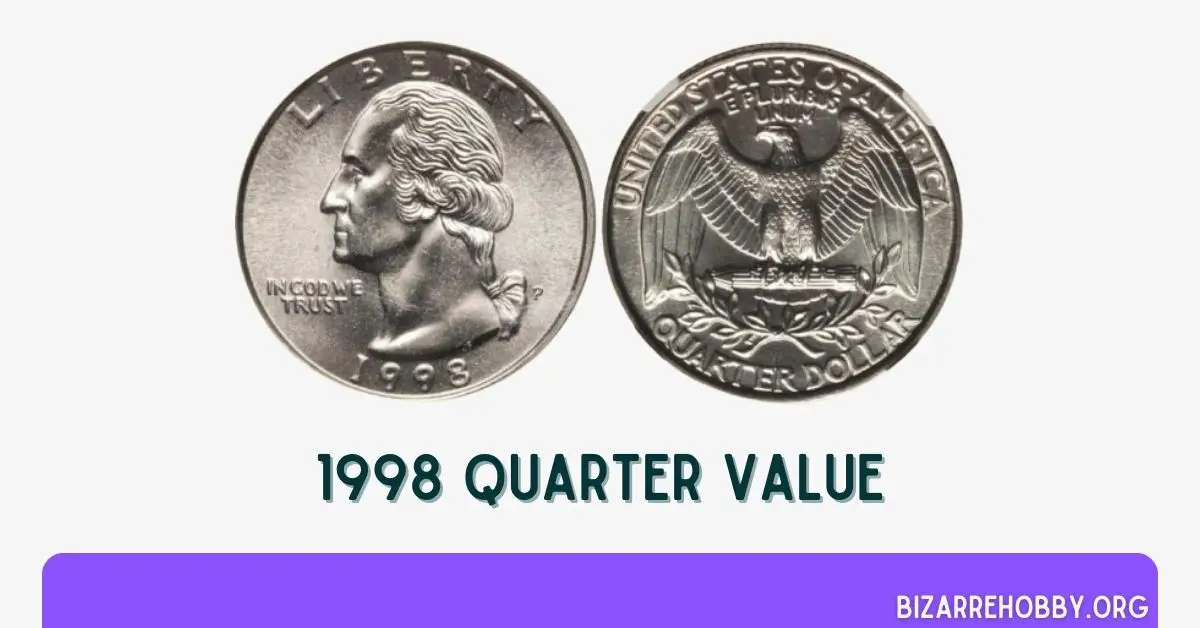The United States Mint’s 1998 Washington quarter, while relatively recent, holds a certain allure for coin enthusiasts. This piece, featuring the iconic profile of America’s first president, George Washington, may not be a rare numismatic treasure, but it still garners interest among collectors.
What’s the actual worth of a 1998 quarter? For most circulated examples, the value doesn’t significantly exceed its face value of 25 cents. However, the coin’s potential increases dramatically when we consider certain minting errors or exceptional quality specimens.
Some coin aficionados specifically focus on acquiring and studying 1998 Washington quarters, searching for those elusive variations that can substantially boost the coin’s value. This specialized interest underscores the importance of understanding the 1998 quarter’s worth, whether you’re contemplating adding one to your collection or considering selling a unique example.
To fully appreciate this coin, it’s beneficial to explore its historical context, physical characteristics, and grading criteria. Additionally, familiarizing yourself with valuable errors can prove advantageous, as these anomalies can significantly increase the coin’s market value.
In the following sections, we’ll delve deeper into these aspects, providing you with comprehensive information to make informed decisions about collecting or trading 1998 Washington quarters.
For those interested in learning more about U.S. coin collecting, the American Numismatic Association’s website offers valuable resources and information. Additionally, the United States Mint’s website provides historical information about their coin productions.
Now, let’s explore the fascinating world of the 1998 Washington quarter in greater detail!
1998 Quarter Value Chart
| Mint Mark | Good | Fine | Extremely Fine | Uncirculated |
|---|---|---|---|---|
| 1998-P Quarter Value | $0.30 | $0.30 | $0.30 | $375 |
| 1998-D Quarter Value | $0.30 | $0.30 | $0.30 | $100 |
| 1998 Silver Proof Quarter Value | – | – | – | $65 |
History Of The 1998 Quarter
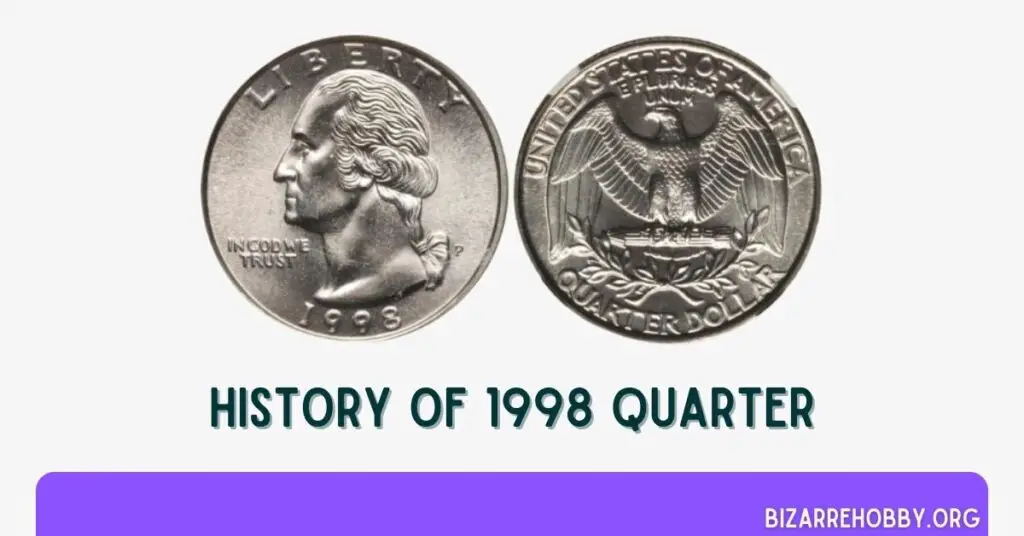
The Washington Quarter Series, introduced in 1932 and continuing to this day, stands as a testament to the enduring legacy of America’s first president. Sculpted by John Flanagan, this coin series pays homage to George Washington’s monumental contributions as a Founding Father and statesman.
The quarter’s inception can be traced back to 1930 when Congress established a Bicentennial Committee to honor Washington’s 200th birth anniversary. Initially, the committee proposed a Washington dollar to replace the Walking Liberty half dollar for the commemorative year.
In collaboration with the Commission of Fine Arts, the committee organized a design competition. Renowned coin designer Laura Gardin Fraser’s submission emerged as the favorite. However, events took an unexpected turn when the House Committee of Coinage intervened, advocating for a permanent replacement of the Standing Liberty Quarter with a Washington Quarter.
Despite objections from the Bicentennial Committee and Fine Arts Commission, Congress enacted legislation authorizing the U.S. Mint to produce a new quarter. This coin would feature Washington’s likeness on the obverse and a national emblem on the reverse.
Another controversy arose when the Mint rejected the committees’ preferred designer, Laura Gardin Fraser. Instead, they initiated a new competition, ultimately selecting John Flanagan’s design for the Washington quarter.
Production commenced in July 1932, with the new quarters entering circulation by August. From 1932 to 1964, these quarters were minted in silver. However, due to rising silver prices, the Mint transitioned to a copper-nickel clad composition in 1965.
While the obverse design has remained largely consistent since 1932, the reverse has undergone several modifications. The year 1998 marked the final appearance of the flying eagle on the reverse. Subsequent years saw various design changes commemorating U.S. territories, national sites, historical figures, and the fifty states.
This rich history underscores the significance of the 1998 Washington quarter as a pivotal point in American numismatics. It represents the culmination of the original design series before the advent of the commemorative reverse designs.
For those interested in delving deeper into the history of U.S. coinage, the National Numismatic Collection at the Smithsonian Institution provides extensive resources and exhibits.
The Features Of The 1998 Quarter
The 1998 Washington quarter boasts distinctive features that set it apart in the realm of American coinage. Understanding these characteristics is crucial for collectors and enthusiasts alike, as it aids in identifying valuable specimens and appreciating the coin’s historical significance.
Obverse Design of 1998 Quarter
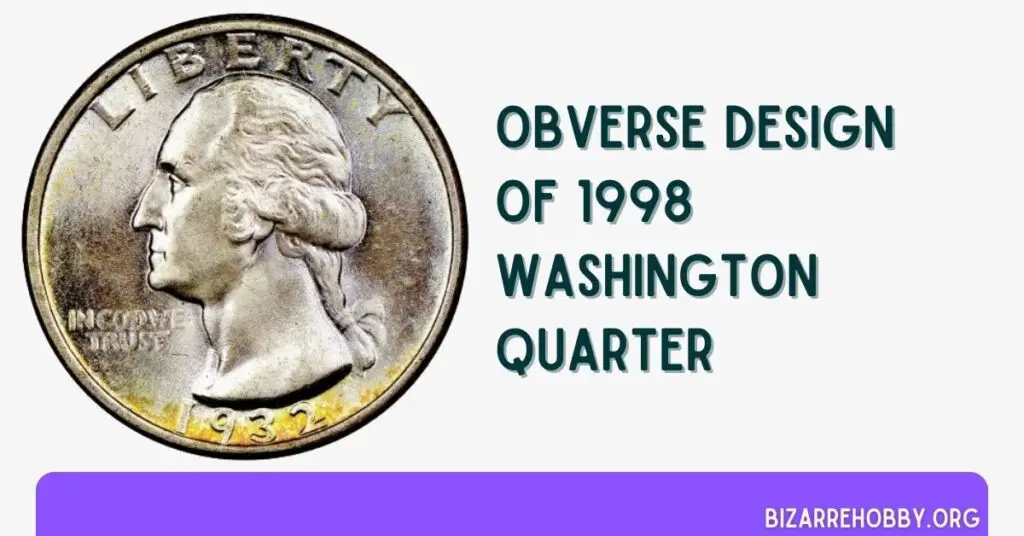
The obverse showcases a dignified portrait of George Washington, the first U.S. President. John Flanagan, the coin’s designer, drew inspiration from Jean-Antoine Houdon’s 1785 bust of Washington. The portrait depicts Washington facing right, his hair gathered in a loose ponytail.
Around the upper rim, “LIBERTY” is prominently inscribed. To the left of Washington’s effigy, the national motto “IN GOD WE TRUST” is engraved. The year of minting, 1998, appears at the bottom.
Reverse Design of 1998 Quarter
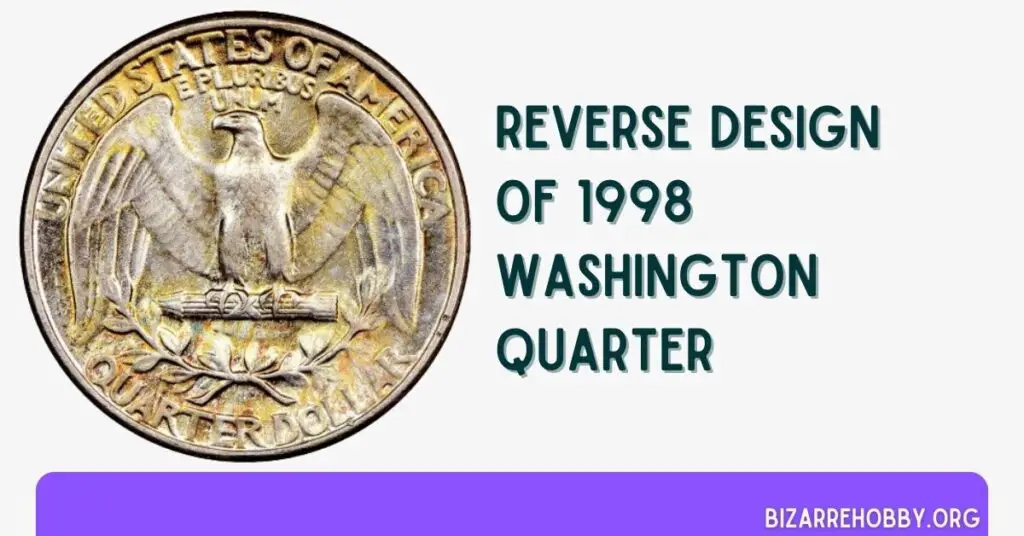
The reverse side of the 1998 quarter is rich in symbolism. It features a majestic bald eagle in flight, wings outstretched, perched upon a bundle of arrows. These arrows symbolize the nation’s readiness to defend its sovereignty and liberty.
Beneath the eagle and arrows lies an olive branch, a universal symbol of peace. This juxtaposition of defensive arrows and the peaceful olive branch reflects the United States’ commitment to peace through strength.
“UNITED STATES OF AMERICA” arches across the top of the reverse, while “QUARTER DOLLAR” is inscribed along the bottom rim. The Latin phrase “E PLURIBUS UNUM” (“Out of many, one”) is positioned above the eagle, embodying the nation’s unity amid diversity.
Composition and Physical Attributes of 1998 Quarter
The 1998 quarter consists of a pure copper core clad with a copper-nickel alloy (75% copper, 25% nickel). It measures 24.30 millimeters in diameter and weighs 5.67 grams. The edge is reeded, a feature that originally deterred counterfeiting and coin shaving.
Three U.S. Mints produced Washington quarters in 1998:
- Philadelphia Mint: No mint mark
- Denver Mint: “D” mint mark
- San Francisco Mint: “S” mint mark (silver proof coins only)
The mint marks, when present, are located on the obverse, near Washington’s ponytail.
For those interested in learning more about coin grading and authentication, the Professional Coin Grading Service (PCGS) and Numismatic Guaranty Corporation (NGC) offer valuable resources and services.
Understanding these features not only enhances appreciation for the 1998 Washington quarter but also aids in identifying potentially valuable specimens, such as those with minting errors or exceptional preservation quality.
1998 Quarter Grading Guides
Understanding the value and grading of 1998 Washington quarters is crucial for collectors and enthusiasts.
Generally, 1998 quarters in circulation don’t command a premium over their face value. The real value lies in uncirculated specimens, which can be worth significantly more than 25 cents.
To determine if a 1998 quarter is uncirculated, focus on specific high points of the design:
Obverse high points
- Washington’s cheek
- Hair details
Reverse high points
- Upper part of the eagle’s legs
- Eagle’s breast
Examination Techniques:
- Single Light Source Method: Place the coin under a single, strong light source. This technique helps reveal:
- Hairline cracks
- Scratches
- Contact marks
- Rotating the Coin: Gently turn the coin under the light. An uncirculated coin will display:
- Bouncing, radiant colors (luster)
- Consistent surface quality
These vibrant colors and the intact luster are typically absent in circulated examples.
Grading Considerations
- Look for a full, unbroken luster across the entire surface.
- Check for any signs of wear, especially on the high points mentioned earlier.
- Examine the fields (flat areas) for any marks or blemishes.
Uncirculated coins are typically graded on a scale from MS-60 to MS-70 (Mint State):
- MS-60 to MS-63: May have some contact marks but full luster
- MS-64 to MS-66: Fewer marks, stronger luster
- MS-67 to MS-70: Nearly perfect to perfect condition
For those interested in professional grading, services like PCGS (Professional Coin Grading Service) or NGC (Numismatic Guaranty Corporation) offer detailed assessments.
Additional Value Factors
- Mint Mark: Coins from certain mints may be more valuable.
- Errors: Minting errors can significantly increase a coin’s value.
- Toning: Natural, attractive toning can enhance value for some collectors.
Remember, while these guidelines are helpful, numismatics is a nuanced field. For valuable or rare specimens, consulting with a professional numismatist or using a reputable grading service is advisable.
| Grade Number | Grade |
|---|---|
| 1 | Basal State-1 |
| 2 | Fair |
| 3 | Very Fair |
| 4, 5, 6 | Good |
| 7, 8, 10 | Very Good |
| 12, 15 | Fine |
| 20, 30 | Very Fine |
| 40 | Extremely Fine |
| 50 | About Uncirculated |
| 60 | Mint State |
| 65 | Mint State |
| 70 | Mint State |
Please check BizarreHobby’s Washington Quarter grading guide to know your coin scale, It’s the necessary step to know the exact value of your quarter.
1998 Quarter Value Guides
So, how much is a 1998 quarter actually worth?
First, let’s make it clear that there are three varieties of the 1998 quarter. These are:
- 1998-P Quarter
- 1998-D Quarter
- 1998-S Silver Proof Quarter
Now, let’s look at how much each is worth.
1998-P Quarter Value
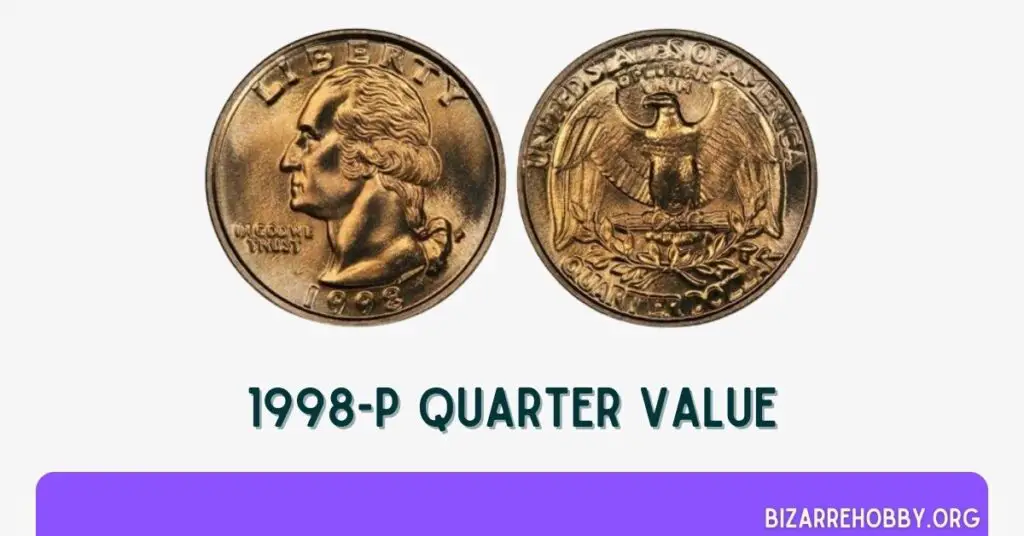
The 1998-P Washington quarter is a common coin, produced in vast quantities by the Philadelphia mint. This translates to affordability for most grades, with circulated examples worth between $0.30 and $0.85. Even well-preserved, uncirculated coins (MS65) can be found for around $10.
Rarity increases for MS66 and above, but prices remain reasonable with MS67 specimens costing around $375. The most valuable coin, graded MS68, fetched a much higher price of $1,380 at auction.
1998-D Quarter Value
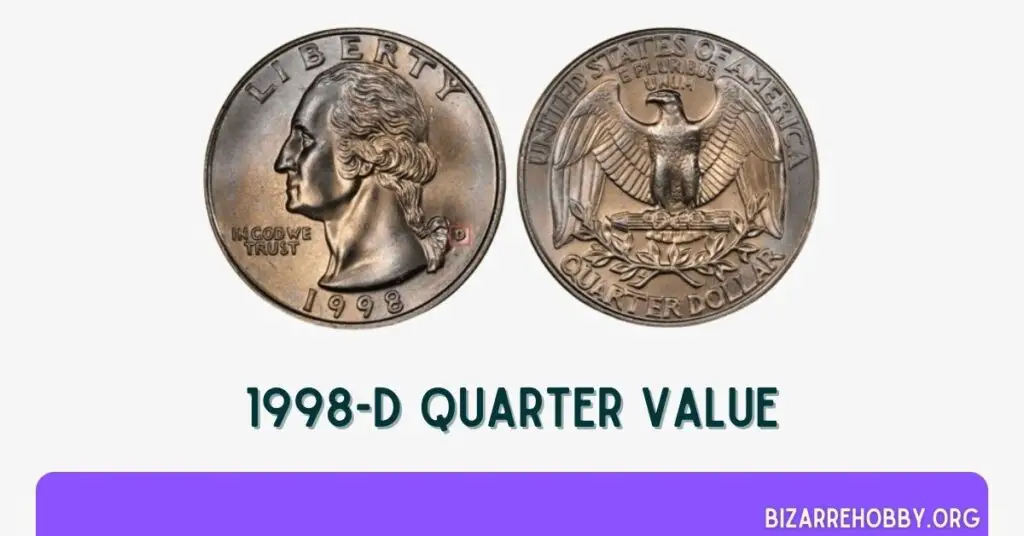
he Denver mint mirrored the Philadelphia mint in 1998, producing a vast number of quarters – a whopping 821,000,000. Like their Philly counterparts, these 1998-D quarters are readily available in circulated grades, valued between $0.30 and $0.85.
Even mint state examples are obtainable for reasonable prices. However, finding uncirculated specimens (MS68+) becomes more challenging due to poor strikes in the late 1980s and 1990s. While there are enough to meet collector demand, a pristine MS67 example can fetch up to $100.
1998-S Silver Proof Quarter Value
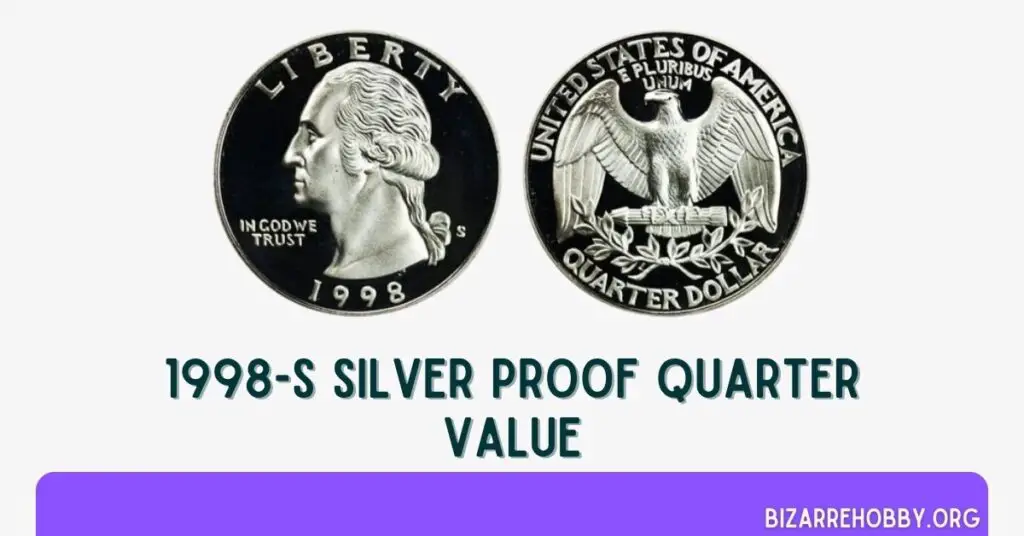
San Francisco joined the party in 1998, producing nearly 873 million Washington quarters with a sharper strike than regular issues. However, despite their good looks, these proof coins (both silver and clad) aren’t particularly valuable due to the high mintage and limited collector interest.
The good news? You can snag a nice-looking proof coin for under $70, with even the rarest specimens (MS70) reaching only around $930. So, these specially minted quarters are surprisingly affordable for collectors.
Rare 1998 Quarter Errors List
While most 1998 Washington quarters aren’t particularly valuable, certain error coins can indeed command significant premiums. Here’s a detailed look at some 1998 quarter errors that collectors seek.
1998 Wounded Eagle Quarter Error
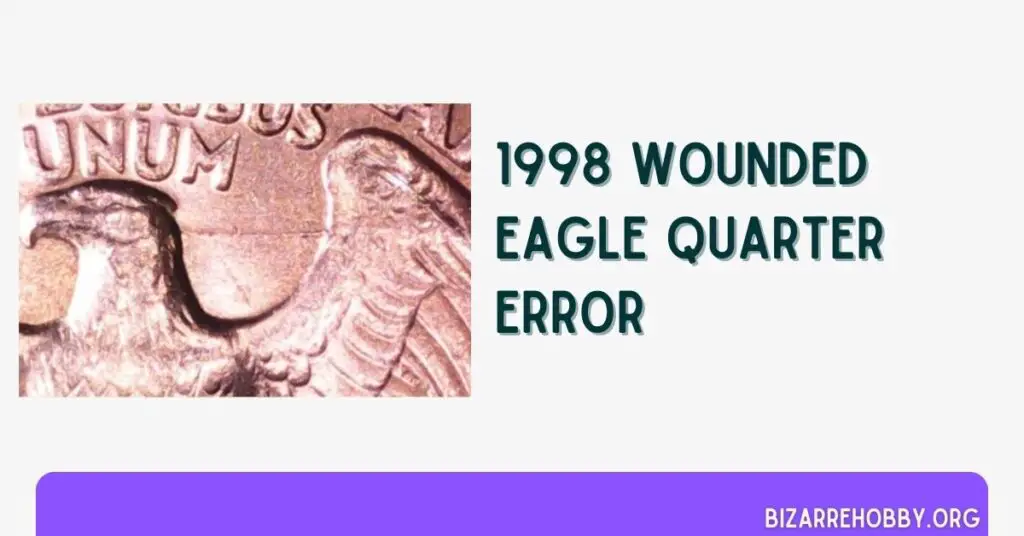
The “wounded eagle” error adds a unique twist to the 1998 Washington quarter. This error appears as a line or cut across the eagle on the back of the coin. While rare, it’s a fascinating find for collectors seeking unusual pieces. Be prepared to shell out at least $430 for a circulated wounded eagle quarter, with prices potentially climbing higher for uncirculated specimens.
1998 Doubled-Die Quarter Error
While the “wounded eagle” error steals the spotlight for unique 1998 Washington quarters, a more common error type exists: the doubled die. This occurs when the die strikes the coin multiple times at slightly different angles, causing a slight duplication of design elements.
The more noticeable the doubling, the more valuable the coin. Look for doubling in areas like “IN GOD WE TRUST,” “LIBERTY,” and the date on the front, or the denomination on the back. These doubled-die 1998 quarters can range from $50 to $150 depending on the severity of the doubling and the overall condition of the coin.
1998 Die Crack Quarter Error
Joining the lineup of interesting errors in 1998 Washington quarters is the die crack error. This occurs when the immense pressure of minting creates cracks in the die itself. If the Mint keeps using this cracked die, the resulting coins will have raised lines of metal where the cracks were filled.
The value hinges on how prominent this raised line is, with larger and more noticeable errors fetching more. A typical 1998 die crack error might fetch $60, but impressive examples with bold lines can reach $100.
1998 Off-Center Quarter Error
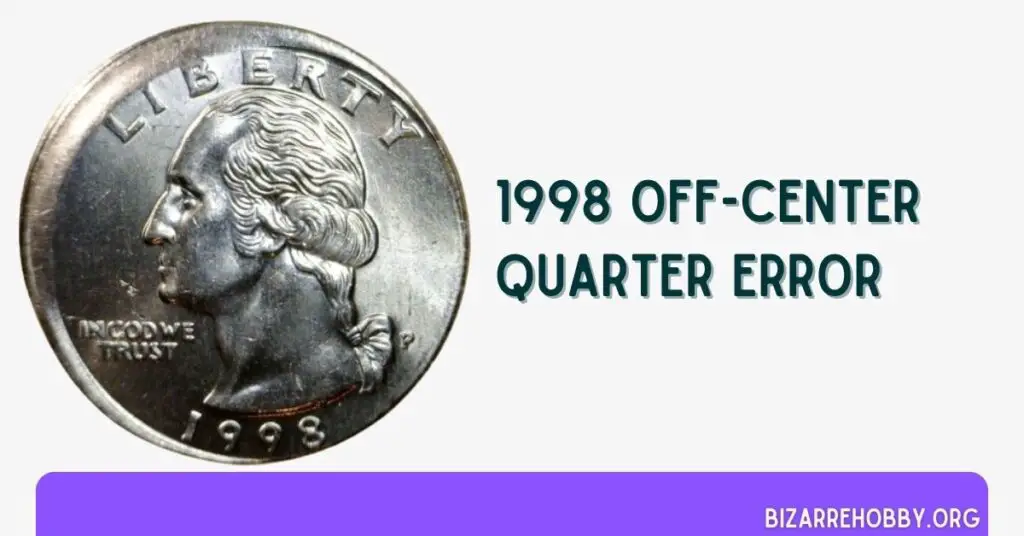
Keep an eye out for off-center errors in your 1998 Washington quarters! These occur when the die isn’t perfectly aligned with the metal blank (planchet), causing the design to be struck off-center.
The more dramatic the offset (think 50% or more off-center), the more valuable the coin becomes. Collectors might pay up to $200 for such a significantly off-center 1998 quarter, while less pronounced off-center errors will have a lower value.
Where To Sell Your 1998 Quarter?
Ready to turn your coin collection into cash? Several online platforms cater to coin sellers. I have specifically written a dedicated guide for Where to sell coins online. This guide will explore some popular options, outlining their features and potential drawbacks to help you choose the best fit for your needs.
FAQs on 1998 Quarters
Are 1998 Silver Quarters Worth Anything?
Despite being proof coins, the 1998 San Francisco silver Washington quarters are surprisingly budget-friendly. In fact, you can snag a beautiful specimen for around $13, making them a great entry point for collectors seeking proof coins.
How Do You Know If You Have A Valuable 1998 Quarter?
Look for mint state condition! These uncirculated coins will have a full shine (luster) across both sides and no signs of wear or rubbing on the raised areas. In top condition, a 1998 mint state quarter will generally outshine its face value.
Is A 1998 D Quarter Worth A Lot Of Money?
Unlike the Philadelphia mint’s 1998 quarters, the Denver mint’s (marked with a “D”) don’t hold much value even in top condition (MS67). While they might look nice, you won’t strike it rich – expect a maximum of $100 for such coins.
